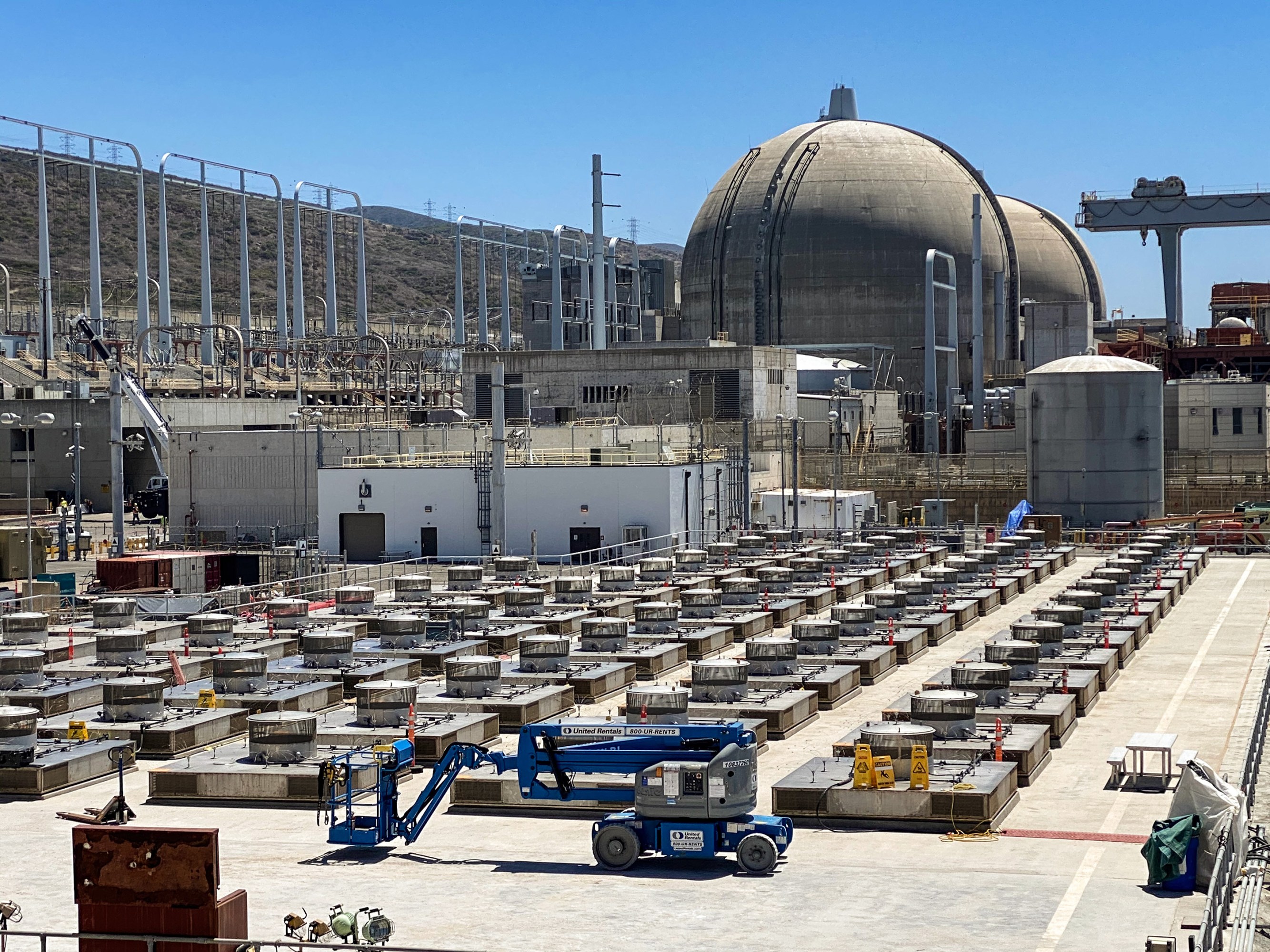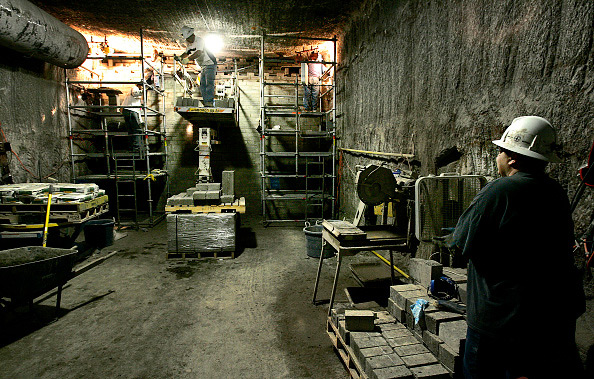At the new Holtec facility, spent nuclear fuel would be shipped in from all over the country and put into interim storage. The proposal for the Holtec site was submitted in 2017 and is still under review by the Nuclear Regulatory Commission. Holtec and ELEA should hear by 2021 whether or not construction can start. If all goes well, the soonest the site could receive waste would be 2023, says Heaton. The waste would be stored in canisters, which would make it easy to retrieve and move once a permanent repository is finally decided upon.
But the nuclear facility won’t only provide storage; it could also create stable work. The oil and gas industry has exploded in Carlsbad over the last three or four years, almost doubling the population. Rapid growth has strained resources in the sleepy, rural town, and RV camps–which locals refer to as “man camps”–have been set up for oil workers and their families. But these energy industries are particularly susceptible to boom-and-bust cycles: today, there’s a slowdown caused by covid-19, since lockdowns reduced the amount of oil required for transportation. Heaton says that nuclear storage could provide more than 200 jobs that would be stable and secure for the very long term.
Despite the economic benefits, some New Mexico state legislators have tried to block the storage facility, citing concerns that it would endanger public safety and other industries. Locals, too, are understandably worried.
“There are the unknowns of nuclear,” says Nick King, a resident of Carlsbad and the preacher at the Carlsbad Mennonite Church. “We’re playing with things we don’t understand.”
Defenders say the Holtec facility won’t be a permanent repository, only a resting spot until Yucca Mountain or its replacement is in operation. But the dispute over Yucca has already taken a generation, and farmers who have resisted being pushed out by the oil and gas boom are concerned about how long the waste will sit there. “I’d like to know what length of time ‘temporary’ means,” says Teresa Ogden, a third-generation farmer living in Loving, a town just south of Carlsbad. “We don’t know the long-term effects. I feel like we’re guinea pigs out here.”

SOUTHERN CALIFORNIA EDISON
It’s not just locals. Tom Isaacs, an advisor to the nuclear industry who is helping San Onofre as it figures out what to do with its nuclear waste, worries that the temporary sites will become effectively permanent–that “people would give up the momentum necessary in order to build the final repository and the storage site will be there forever.”
People are also scarred by New Mexico’s own history with the nuclear industry. The state was home to the test of the first atomic bomb in 1945, which is thought to have caused many cancers and other health problems throughout the basin range that was downwind from the test site.
“New Mexico has paid its dues,” says Gene Harbaugh, who has lived in Carlsbad for the last 30 years. “We don’t owe anything to the nuclear industry.”
What if we didn’t have to create new repositories? What if, instead, sites already designated for nuclear material could store it more safely? That was one of the questions that environmentalist Elizabeth Muller started thinking about in 2015. But when she asked experts what could be done with nuclear waste, she got immediate pushback: “People in the business said, ‘There’s no appetite for new ideas in nuclear waste. Nothing ever happens in this industry.'” But, she adds, “just because nothing has ever happened in nuclear waste doesn’t mean you should dismiss it as ‘Nothing’s ever going to happen.'”
As relative newcomers to the field, Muller and her father–the physicist and reformed climate change skeptic Richard A. Muller–heard policy advisors and engineers talk about how boreholes, drilled deep in the earth by the oil and gas industries, could also be used for storage. In 2016, the Mullers founded Deep Isolation, a private company based in Berkeley, California, to explore using them for nuclear material.
The company’s top priority is to get the waste below ground; accidents above ground can spell catastrophe. But the Mullers realized that one contentious issue plaguing Yucca Mountain and WIPP was the transportation of nuclear waste across state lines.
“People don’t want nuclear waste coming through their backyard,” Elizabeth Muller explains. Deep Isolation plans to circumvent that entirely by burying waste where it is, whether that is around an existing power plant or near some other Department of Energy facility. (Long-term burial at any non-designated facility would require community consent.)
“People really want a solution for climate change. There’s no smokestack at a nuclear plant, but … if we’re going to deploy more nuclear energy, this waste question is a big one.”
Their method involves drilling holes 18 inches in diameter and between 1,000 and 3,000 meters deep, and then drilling sideways to create a place to bury specially designed, corrosion-resistant cylinders that store spent fuel assemblies. Each canister is a little larger than a nuclear fuel rod assembly–more like a glove around the spent fuel than the vast barrels at San Onofre–and they are shuttled down the hole in a chain of two or three.
One benefit of this method, says Muller, is that the same technique could serve for both temporary and permanent storage. In January 2019, Deep Isolation proved that canisters could not only be sent underground but also retrieved, should the DOE manage to create a permanent repository elsewhere at some later point and want to transfer material there.
Their method won’t work everywhere, though. SONGS, for example, is located on land that will eventually have to be returned to its owner, the US Navy.
Despite the company’s proof-of-principle experiment, others are skeptical that Deep Isolation’s method will necessarily be safe.
Lindsay Krall, a geochemist who researches nuclear waste burial at Stanford University, worries that the company’s canisters wouldn’t be buried deep enough to prevent waste from leaking into the biosphere. What’s more, the narrow boreholes can only accommodate thin canisters, which may be insufficient for long-term safety.
“There is no reason to expect that borehole disposal of spent fuel will attain cost savings,” Krall says. “Rather, [it] represents a technological risk, with a significant opportunity for failure that would result in increased disposal costs and decreased public safety.”
But John Grimsich, Deep Isolation’s director of applied science, says that burial sites they choose will have ideal geology for long-term storage, far away from sources of groundwater. The highest radiation doses that Muller and her colleagues have calculated at the ideal sites are lower by a factor of 10,000 than the average exposure a person receives annually from the planet’s background radiation.
Given the amount of waste already out there, some believe it would be more responsible to simply create less of it. But can that be done without giving up nuclear, one of the best carbon-free options for generating energy?
One option is to reuse the waste. In France, nuclear waste has been reprocessed since the dawn of the industry in the 1940s. Since 1976, the nuclear power and renewable energy group Orano has processed more than 36,000 metric tons of used fuel, which is responsible for generating 10% of France’s nuclear electricity. Orano’s plant recycles around 1,100 metric tons per year.

BRIAN VANDER BRUG/LOS ANGELES TIMES VIA GETTY
The process of recycling nuclear fuel takes years. Spent fuel rods are taken from nuclear reactors and placed in a storage pool to cool for two years. When they get to around 570 ?F, the fuel rods are packed into steel canisters and brought to the Orano plant in the northwesternmost point in France, in the town of La Hague. After the rods cool below 80 ?F, they are cut into smaller pieces before being placed in nitric acid and dissolved. Then the recyclable material–a mixture of uranium and plutonium–gets separated from other fission products in the spent fuel and purified. Finally, it is remixed to produce new fuel.
The US has developed its own approved technology for reprocessing, but in 2007 the Nuclear Regulatory Commission decreed that it would be too expensive to pursue without an investment from the DOE–which has not materialized.


